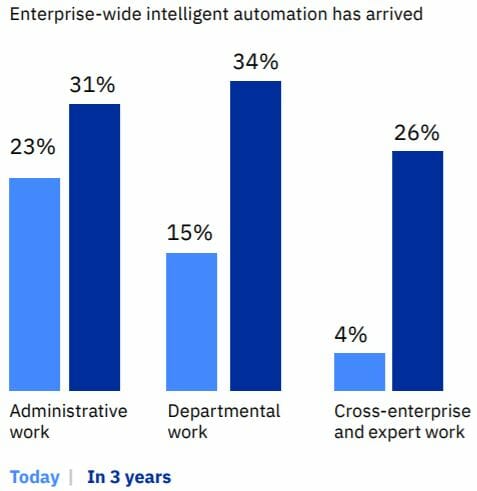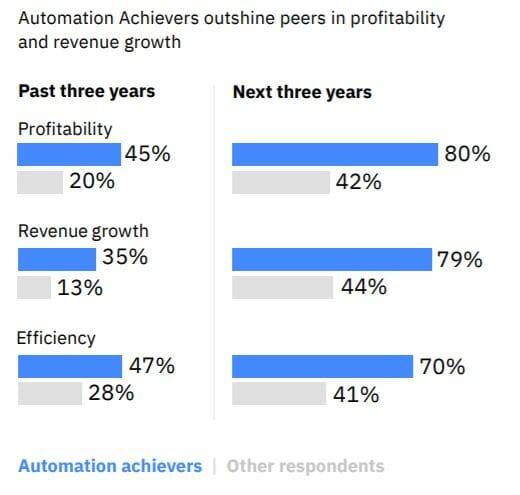By Catherine Lian, Managing Director of IBM Malaysia,
Today’s operations must be dynamic, responsive, and interconnected to an organization’s ecosystem and workflows. Undoubtedly, deploying intelligent automation across an enterprise and ecosystem can build a more adaptable business, one that can rapidly respond, pivot, scale up or down, and adopt new operating models. It is not necessarily the fittest, fastest, or strongest that will survive future disruptions—but the most adaptable.
In collaboration with Oxford Economics, IBM Institute for Business Value (IBV) conducted a comprehensive study that revealed that the nature of machine work would change significantly by 2024. The percentage of tasks overall— administrative, departmental, and cross-enterprise and expert—will continue to grow substantially. According to the study, 80 percent of organizations scaling intelligent automation expect to outperform the competition in profitability within three years.

Over the decades, automation has touched most industries – from the factory floor to banking transactions and oil refineries. Artificial Intelligence (AI) or intelligent automation are altering how humans and machines interact, how data is analyzed, decisions are made, and tasks and activities within a workflow or system are performed.
In Malaysia, the government has introduced several initiatives to boost the adoption of innovative technologies in the local industries. This aligns with the government’s aim to implement a conducive industrial development policy and ensure market expansion through international trade does not affect the local industry, especially the high-tech sector.
In order to boost automation in the manufacturing sector, the government has introduced various initiatives such as the enhancement and expansion of the existing Domestic Investment Strategic Fund (DISF) under the short-term economic Recovery Plan, PENJANA, which aims to drive the local companies’ upward transition on the value chain.[1]
Additionally, the Smart Automation Grant introduced under PENJANA also aims to help small and medium-sized enterprises and middle-tier companies to digitalise their operations and enhance efficiency in the manufacturing, production and high value-added services sectors.
IBM collaborated with SMART Modular Technologies (SMART), a leading supplier of speciality memory, and storage solutions manufacturer, to transform its Penang operations into a cutting-edge facility boasting Industry 4.0 manufacturing processes, including both the deployment of new AI-powered capabilities and re-skilling its workforce. SMART’s Penang operations use artificial intelligence-enabled collaborative robots (COBOTS) powered by IBM PowerAI Vision. By deploying COBOTS, SMART will be able run test stations on the manufacturing floor to automate and improve testing capabilities. This collaboration enabled SMART to deliver top quality value to its customers, continuously reduce cost and drive productivity.

According to the IBV study, in just three years, the nature of machine work will change dramatically, with both the percentage of tasks and the level of their complexity growing. Implementing intelligent automation across an enterprise establishes a human-technology partnership that can improve and scale over time at a rate that exceeds traditional technological progress. These intelligent workflows aren’t just automated, optimized, and personalized; they’re dynamic and can flex and scale with ease to create new value.
Intelligent workflows – Revolutionizing the way the business works
Using intelligent workflows can free humans from repetitive, reactive tasks that technology can now perform. In fact, IBM research “How Smarter Businesses Transform in an Uncertain World” has shown that 74% of companies that invested in intelligent workflows for talent have seen productivity increases. Freeing humans to do higher-value work helps achieve the ultimate goal of transformation: unlocking value.
Business leaders have a tremendous opportunity to change the way they operate. Today, they can accelerate and expand digital initiatives and transform the way they create value and sustain differentiation. The impetus for change comes from within and is an opportunity to redesign workflows and use technology to make it faster and easier to get work done. A consumer products company increased their billing practitioner’s efficiency by 35% while increasing customer satisfaction by 25%.
By reimagining work as a fluid experience across the enterprise, intelligent workflows enable employees to work at the optimal intersection of skills, data, technology and opportunity. Intelligent workflows can be a driver for growth.
Preparing the talent for the future of work
Advanced automation brings together humans and machines to integrate multiple systems and executive functions across an enterprise. However, businesses cannot rely on technology alone to drive transformation. They must also create a culture of ongoing, humancentric innovation.
Transformation must make the employee experience a top priority. This is especially important considering that competition for skilled employees is growing fiercer. This is not a “once-and-done,” but an ongoing effort to keep skills and engagement programs in pace with advancing technology.
One of the most obvious consequences of the current Covid-19 pandemic will be “the infusion of data-enabled services into ever more aspects of life.” We expect digital transformation to be an even bigger imperative for organizations in the short-term future.
Digital transformation is not about technology alone but more about the people. Business leaders can invest in any technology, but the ability to adapt to an even more digital future depends on developing the next generation of skills, closing the gap between talent supply and demand, and future-proofing ours and others’ potential.









